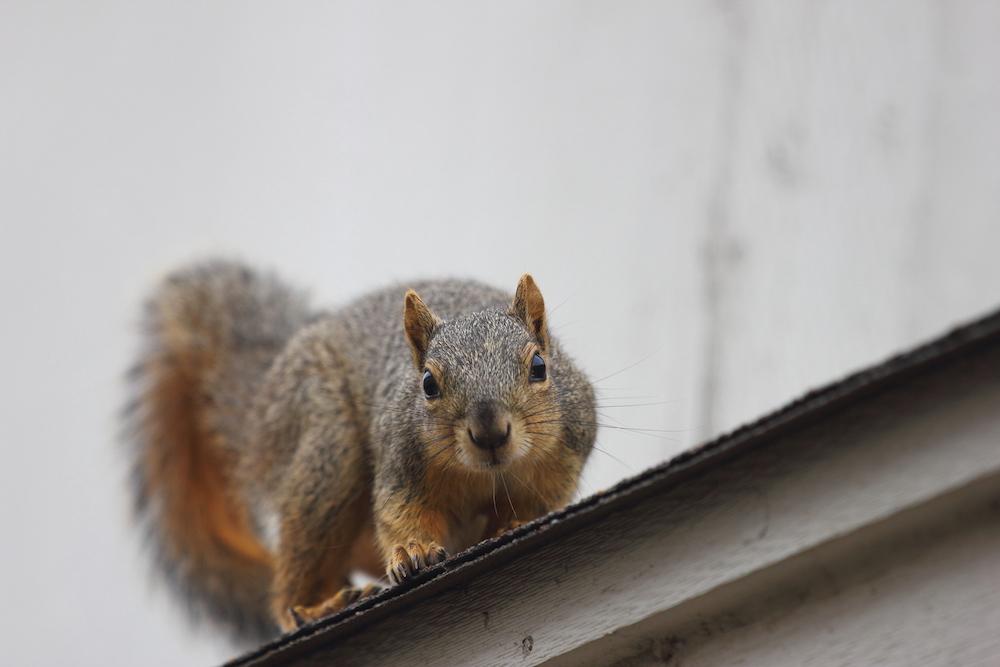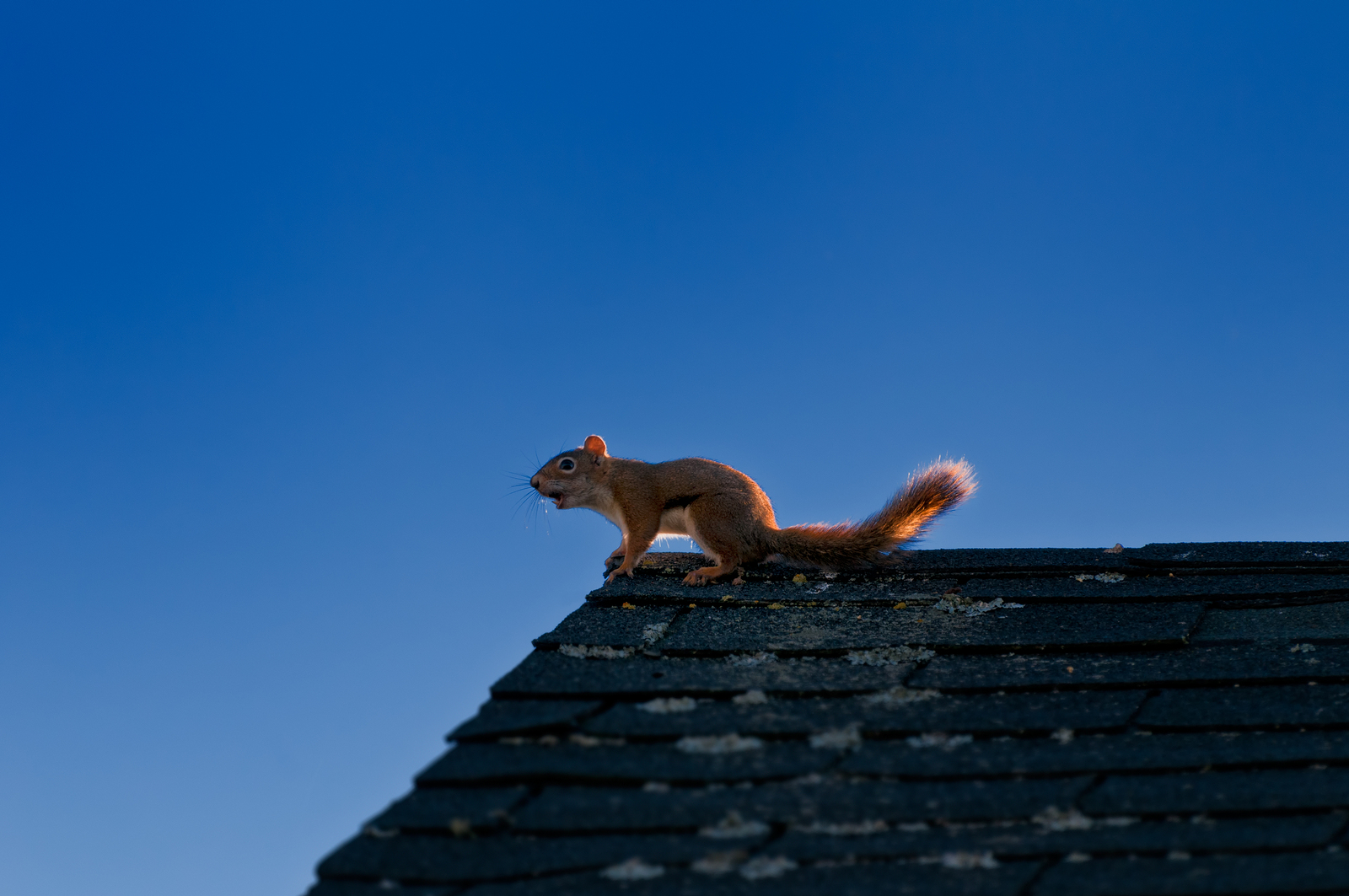READY TO GET STARTED?
REQUEST A FREE ESTIMATE
Fill out the form below or call (888) 466-7849 for a free, no-obligation estimate.

Hearing noises at night? You may have squirrels nesting in the attic, looking for shelter from the cold. To get rid of squirrels, first you have to determine how they’re getting in. This can be tricky if you don’t have easy access to your roof and since squirrels can sneak into small spaces. Contact a wildlife removal company to fully inspect your home for squirrel access points, set up traps, and correct any damage caused by squirrels. It’s also a good idea to keep trees trimmed and away from your roofline to cut off direct access.
Raccoons are common home invaders in the winter months, looking for refuge in crawl spaces, attics, and chimneys. Similar to squirrels, effective raccoon control requires professional expertise – to identify and seal entry points, trap and remove the raccoons, and prevent them from coming back with exclusion techniques. To prevent a raccoon invasion, eliminate food sources that attract them by using outdoor trash bins with lids and removing pet food when it’s not being eaten.
Mice are year-round pest nuisances that typically nest in attics, basements, cabinets, and closets. And because mice can fit through gaps as small as 1/4 inch, keeping them out can be difficult. As with other rodent control methods, the first step is to inspect your home for cracks, gaps, holes, or any other openings and correct them. Secondly, eliminate food sources and hiding places by keeping a clean house, removing clutter, and storing food in sealed containers. If you see small, dark-colored droppings anywhere, call an exterminator – quarterly pest control treatments are recommended to get rid of mice and prevent a future infestation.
Similar to mice, rats are common winter invaders, searching for food and warmth inside your home, needing holes as small as a quarter to get in. To prevent this, and other rodent invasions, seal any gaps or holes in your home’s foundation, around your roof, in the crawl space or basement, or around doors and windows, keep garbage away from your home’s exterior in sealed bins, and check for evidence of rats – usually indicated by droppings (larger than those left by mice), gnawing, or footprints and tail tracks.
Cockroaches, too, are looking for food and warmth during colder months. The best way to prevent roaches is with preventative pest control and by eliminating what attracts roaches – food left out, crumbs, pet food and water, clutter, and water leaks.
Common house spiders will start making their ways indoors starting in the cooler, Fall months. Prevent spiders with ongoing pest control treatments, by eliminating clutter (spiders like to hide in dark, undisturbed places), and by knocking down cobwebs regularly.

Squirrels may seem cute and harmless…until they’re seeking warmth and shelter inside your home. As the weather gets colder, it’s common for small animals like squirrels to nest in your attic, usually gaining access from gaps around your roofline, through vents, or even chimneys. Other than being annoyingly noisy, squirrels can cause major damage inside your home by chewing on wires, which can lead to power outages or fire, by contaminating storage areas and insulation with fur, urine, and droppings, and by allowing other pests or rodents to enter your home through holes they’ve created to gain access into your home.
Because squirrels can chew through a lot of roofing materials, like wood, aluminum, or shingles, and fit through small openings, gaining access points into your attic is easy. If you see any gaps or holes, use wire to seal off the areas and caulking to seal smaller cracks and crevices.
If you’re sealing gaps, it’s possible to trap squirrels inside your attic where they could eventually die or create more damage by chewing their way out in other places. By trapping the squirrels, you can prevent this from happening. Trapping should be done by someone that’s experienced; we recommend calling in a wildlife control company for this that uses live traps and places the traps in strategic areas that the squirrels are likely to come across. Once the squirrels are caught, they should be moved outside of your home, far enough away so as not to tempt them to return.
Keeping tree limbs cut back and trimmed will further prevent squirrels from gaining access to your attic. Squirrels use tree limbs as a direct route onto your roof; cutting off these access points will eliminate a source of entry.
To get rid of squirrels isn’t an easy task. It often requires the knowledge and expertise of a wildlife control company. It’s equally as important to trap and remove the squirrels as it is to prevent them from coming back. A squirrel control professional will know how to find the squirrels, the most effective trapping and removal methods, and provide services and recommendations for future squirrel prevention.

Squirrels may seem cute and harmless…until they’re seeking warmth and shelter inside your home. As the weather gets colder, it’s common for small animals like squirrels to nest in your attic, usually gaining access from gaps around your roofline, through vents, or even chimneys. Other than being annoyingly noisy, squirrels can cause major damage inside your home by chewing on wires, which can lead to power outages or fire, by contaminating storage areas and insulation with fur, urine, and droppings, and by allowing other pests or rodents to enter your home through holes they’ve created to gain access into your home.
Because squirrels can chew through a lot of roofing materials, like wood, aluminum, or shingles, and fit through small openings, gaining access points into your attic is easy. If you see any gaps or holes, use wire to seal off the areas and caulking to seal smaller cracks and crevices.
If you’re sealing gaps, it’s possible to trap squirrels inside your attic where they could eventually die or create more damage by chewing their way out in other places. By trapping the squirrels, you can prevent this from happening. Trapping should be done by someone that’s experienced; we recommend calling in a wildlife control company for this that uses live traps and places the traps in strategic areas that the squirrels are likely to come across. Once the squirrels are caught, they should be moved outside of your home, far enough away so as not to tempt them to return.
Keeping tree limbs cut back and trimmed will further prevent squirrels from gaining access to your attic. Squirrels use tree limbs as a direct route onto your roof; cutting off these access points will eliminate a source of entry.
To get rid of squirrels isn’t an easy task. It often requires the knowledge and expertise of a wildlife control company. It’s equally as important to trap and remove the squirrels as it is to prevent them from coming back. A squirrel control professional will know how to find the squirrels, the most effective trapping and removal methods, and provide services and recommendations for future squirrel prevention.
Squirrels are cute when they’re running around outside but are not so cute when they’ve entered your home. Squirrels are difficult to control because of their ability to enter small and high spaces. They are known to get into houses by using tree limbs and even power lines to squeeze their way into the smallest openings, chimneys, or vents. Once squirrels are inside they can cause significant damage and contaminate your home.
Squirrels can cause considerable damage to your property. Their gnawing can damage wires (leading to power outages and potential house fires), holes in the structure (allowing other pests/rodents entry into the home) and damage or contaminate insulation. They can invade and damage items that you may have stored away, including storage boxes and their content. Outside items like electrical boxes and phone cables can also become a victim of squirrel damage.
In addition to property damage, squirrels can contaminate your property. Contamination from their fur, urine, and droppings can damage insulation, items in storage, electrical wiring, among other things.
Although squirrels are a threat all year, the cooler months, when they seek warmth and shelter, are a main concern. Prevention is the key to squirrel control: